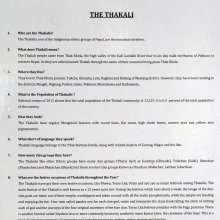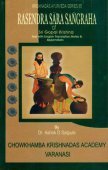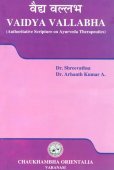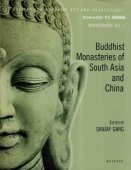Pandu, Pāṇḍu, Paṇḍu, Pandū, Pamdu, Pamde: 37 definitions
Introduction:
Pandu means something in Buddhism, Pali, Hinduism, Sanskrit, Marathi, Jainism, Prakrit, Hindi. If you want to know the exact meaning, history, etymology or English translation of this term then check out the descriptions on this page. Add your comment or reference to a book if you want to contribute to this summary article.
Images (photo gallery)
In Hinduism
Ayurveda (science of life)
Nighantu (Synonyms and Characteristics of Drugs and technical terms)
Source: WorldCat: Rāj nighaṇṭuPāṇḍu (पाण्डु) is another name for Paṭola, a medicinal plant identified with Trichosanthes dioica (pointed gourd) from the Cucurbitaceae or “gourd family” of flowering plants, according to verse 3.22-24 of the 13th-century Raj Nighantu or Rājanighaṇṭu. The third chapter (guḍūcyādi-varga) of this book contains climbers and creepers (vīrudh). Together with the names Pāṇḍu and Paṭola, there are a total of sixteen Sanskrit synonyms identified for this plant.
Dietetics and Culinary Art (such as household cooking)
Source: Shodhganga: Dietetics and culinary art in ancient and medieval IndiaPāṇḍu (पाण्डु) or Pāṇḍuroga refers to “jaundice” according to the 17th century Bhojanakutūhala (dravyaguṇāguṇa-kathana), and is commonly found in literature dealing with the topics of dietetics and culinary art, also known as Pākaśāstra or Pākakalā.—Accordingly, the dietetic effect pāṇḍu-ghna (cures jaundice) is associated with the following conditions: Food utensils made of Pāṭalapatra (patra=leaves). The dietetic effect pāṇḍu-hara (treatment of jaundice) is associated with the following conditions: Food utensils made of Āyasa (iron) and Kāca (glass).
Rasashastra (Alchemy and Herbo-Mineral preparations)
Source: Wisdom Library: Rasa-śāstraPāṇḍu (पाण्डु) refers to “anaemia” according to the fifth volume of the Rasajalanidhi (chapter 13). Accordingly, “Pandu is of five different kinds, according as it is due to (a) vayu, (b) pitta, (c) kapha, (d) combination of the three, and (e) eating of earth.
Symptoms of anemia:—Discolouredness, swelling of the limbs, emaciation, loss of weight, and fatigue—are the symptoms of the disease”.
Unclassified Ayurveda definitions
Source: Wisdom Library: Āyurveda and botanyPāṇḍu (पाण्डु, “anemia”) is a Sanskrit term used in Ayurveda.
Source: archive.org: Vagbhata’s Ashtanga Hridaya Samhita (first 5 chapters)Pāṇḍu (पाण्डु) refers to “jaundice”, as mentioned in verse 5.12, 13-14 of the Aṣṭāṅgahṛdayasaṃhitā (Sūtrasthāna) by Vāgbhaṭa.—Accordingly, “[...] (those) [rivers, viz., nadī] again springing from the Sahya and Vindhya; [produce] leprosy, jaundice [viz., pāṇḍu], and diseases of the head; (those) coming from the Pāriyātra (are) destructive of the (three) humours (and) promotive of strength and virility”.
Source: Research Gate: Internal applications of Vatsanabha (Aconitum ferox wall)Pāṇḍu (पाण्डु) refers to “anaemia” (a decrease in the total amount of red blood cells or hemoglobin in the blood, or a lowered ability of the blood to carry oxygen). Medicinal formulations in the management of this condition include 22 references of Vatsanābha usages. Guṭikā is maximum (17) dosage form in the management of Pāṇḍu. Vatsanābha (Aconitum ferox), although categorized as sthāvara-viṣa (vegetable poisons), has been extensively used in ayurvedic pharmacopoeia.
Source: Ancient Science of Life: Vaidyavallabha: An Authoritative Work on Ayurveda TherapeuticsPāṇḍu (पाण्डु) refers to “anaemia”, and is dealt with in the 17th-century Vaidyavallabha (chapter 6) written by Hastiruci.—The Vaidyavallabha is a work which deals with the treatment and useful for all 8 branches of Ayurveda. The text Vaidyavallabha has been designed based on the need of the period of the author, availability of drugs during that time, disease (viz., pāṇḍu) manifesting in that era, socio-economical-cultural-familial-spiritual-aspects of that period Vaidyavallabha.
Source: gurumukhi.ru: Ayurveda glossary of termsPāṇḍu (पाण्डु):—Pale colour

Āyurveda (आयुर्वेद, ayurveda) is a branch of Indian science dealing with medicine, herbalism, taxology, anatomy, surgery, alchemy and related topics. Traditional practice of Āyurveda in ancient India dates back to at least the first millenium BC. Literature is commonly written in Sanskrit using various poetic metres.
Vaishnavism (Vaishava dharma)
Source: ISKCON Press: GlossaryPāṇḍu (पन्दु).—A great king of the Kuru dynasty, and the father of the Pāṇḍavas, Yudhisthira, Bhima, Arjuna, Nakula and Sahadeva; the heroes of the Mahābhārata. He had two wives, Kuntī and Mādrī. He was a younger brother of Dhṛtarāṣṭra's who died early, leaving his five young sons under the care of Dhṛtarāṣṭra.
Source: Pure Bhakti: Bhagavad-gita (4th edition)Pāṇḍu (पाण्डु) refers to “the great king of the Kuru dynasty and younger brother of Dhṛtarāṣṭra. He died an untimely death and left his five sons, the Pāṇḍavas, under the care of Dhṛtarāṣṭra”. (cf. Glossary page from Śrīmad-Bhagavad-Gītā).

Vaishnava (वैष्णव, vaiṣṇava) or vaishnavism (vaiṣṇavism) represents a tradition of Hinduism worshipping Vishnu as the supreme Lord. Similar to the Shaktism and Shaivism traditions, Vaishnavism also developed as an individual movement, famous for its exposition of the dashavatara (‘ten avatars of Vishnu’).
Purana and Itihasa (epic history)
Source: Wisdom Library: Bhagavata PuranaPāṇḍu (पाण्डु):—One of the sons of Vyāsa (the popular name for Bādarāyaṇa, who was begotten by Parāśara Muni through the womb of Satyavatī). Being cursed by a sage, he was restrained from sexual life. His three sons (by kunti), named Yudhiṣṭhira, Bhīma and Arjuna, were begotten through the womb of his wife, Kuntī, by Dharmarāja (god of wind). His second wife, named Mādrī, gave birth to Nakula and Sahadeva, who were begotten by the two Aśvinī-kumāra brothers named Nāsatya and Dasra. (see Bhāgavata Purāṇa 9.22.25)
Source: archive.org: Puranic Encyclopedia1) Pāṇḍu (पाण्डु).—Father of the Pāṇḍavas. Genealogy. Refer to the genealogy of Arjuna. (See full article at Story of Pāṇḍu from the Puranic encyclopaedia by Vettam Mani)
2) Pāṇḍu (पाण्डु).—The second son of. Janamejaya. (Chapter 94, Ādi Parva).
Source: Cologne Digital Sanskrit Dictionaries: The Purana Index1a) Pāṇḍu (पाण्डु).—A Rājaṛṣi: one of the three sons of Vicitravīrya; (Kṛṣṇadvaipāyana, Vāyu-purāṇa) born to Vyāsa; married two wives, Kunti alias Prthā, sister of Vasudeva and Mādri; father of the five Pāṇḍavas, who were born to Kunti by favour of Gods, himself being prevented by a curse from having sexual intercourse; on his death Pṛthā with the young children underwent a lot of difficulties.*
- * Bhāgavata-purāṇa I. 4. 7; IX. 22. 25, 27; 24. 36; I. 9. 13. Matsya-purāṇa 46. 8; 50. 47-9; Vāyu-purāṇa 96. 150; 99. 242-3; 112. 45; Viṣṇu-purāṇa IV. 14. 34; 20. 38-42.
1b) An Ārṣeya Pravara (Āngīras).*
- * Matsya-purāṇa 196. 9.
1c) A son of Vidhāta and Āyatī; married Puṇḍarīkā and had a son Dyutimān.*
- * Vāyu-purāṇa 28. 5, 35.
Pāṇḍu (पाण्डु) is a name mentioned in the Mahābhārata (cf. I.63.95, I.63, I.89.49) and represents one of the many proper names used for people and places. Note: The Mahābhārata (mentioning Pāṇḍu) is a Sanskrit epic poem consisting of 100,000 ślokas (metrical verses) and is over 2000 years old.

The Purana (पुराण, purāṇas) refers to Sanskrit literature preserving ancient India’s vast cultural history, including historical legends, religious ceremonies, various arts and sciences. The eighteen mahapuranas total over 400,000 shlokas (metrical couplets) and date to at least several centuries BCE.
Natyashastra (theatrics and dramaturgy)
Source: Wisdom Library: Nāṭya-śāstraPāṇḍu (पाण्डु, “yellowish white”) refers to a derivative color, composed of the white (sita) and the yellow (pīta) colors, according to Nāṭyaśāstra chapter 23. According to the science of āhāryābhinaya (extraneous representation), there are four main colors (varṇa) from which various derivative and minor colors (upavarṇa) are derived. Colors are used in aṅgaracanā (painting the limbs), which forms a section of nepathya (costumes and make-up).

Natyashastra (नाट्यशास्त्र, nāṭyaśāstra) refers to both the ancient Indian tradition (shastra) of performing arts, (natya—theatrics, drama, dance, music), as well as the name of a Sanskrit work dealing with these subjects. It also teaches the rules for composing Dramatic plays (nataka), construction and performance of Theater, and Poetic works (kavya).
Kavya (poetry)
Source: Wisdom Library: KathāsaritsāgaraPāṇḍu (पाण्डु) is the name of a king of olden times, and ancestor of Udayana (king of Vatsa), according to the Kathāsaritsāgara, chapter 21. Accordingly, when sage Nārada cam to visit Udayana, he related: “Listen, O King; I will tell you a story in a few words. You had an ancestor once, a king of the name of Pāṇḍu; he like you had two noble wives; one wife of the mighty prince was named Kuntī and the other Mādrī. That Pāṇḍu conquered this sea-engirdled earth, and was very prosperous.”
The Kathāsaritsāgara (‘ocean of streams of story’), mentioning Pāṇḍu, is a famous Sanskrit epic story revolving around prince Naravāhanadatta and his quest to become the emperor of the vidyādharas (celestial beings). The work is said to have been an adaptation of Guṇāḍhya’s Bṛhatkathā consisting of 100,000 verses, which in turn is part of a larger work containing 700,000 verses.

Kavya (काव्य, kavya) refers to Sanskrit poetry, a popular ancient Indian tradition of literature. There have been many Sanskrit poets over the ages, hailing from ancient India and beyond. This topic includes mahakavya, or ‘epic poetry’ and natya, or ‘dramatic poetry’.
Jyotisha (astronomy and astrology)
Source: Wisdom Library: Brihat Samhita by VarahamihiraPāṇḍu (पाण्डु) refers to a country belonging to “Madhyadeśa (central division)” classified under the constellations of Kṛttikā, Rohiṇī and Mṛgaśīrṣa, according to the system of Kūrmavibhāga, according to the Bṛhatsaṃhitā (chapter 14), an encyclopedic Sanskrit work written by Varāhamihira mainly focusing on the science of ancient Indian astronomy astronomy (Jyotiṣa).—Accordingly, “The countries of the Earth beginning from the centre of Bhāratavarṣa and going round the east, south-east, south, etc., are divided into 9 divisions corresponding to the 27 lunar asterisms at the rate of 3 for each division and beginning from Kṛttikā. The constellations of Kṛttikā, Rohiṇī and Mṛgaśīrṣa represent the Madhyadeśa or central division consisting of the countries of [i.e., Pāṇḍu] [...]”.

Jyotisha (ज्योतिष, jyotiṣa or jyotish) refers to ‘astronomy’ or “Vedic astrology” and represents the fifth of the six Vedangas (additional sciences to be studied along with the Vedas). Jyotisha concerns itself with the study and prediction of the movements of celestial bodies, in order to calculate the auspicious time for rituals and ceremonies.
General definition (in Hinduism)
Source: Apam Napat: Indian MythologyPandu was the son of the Kashi princess Ambalika, by Vyasa. He was deemed to be a descendant of his mother's husband Vichitraveerya, who had died issueless. He was born pale, as his mother had turned pale with fright while conceiving him. Since his elder brother Dhritharashtra was born blind, Pandu was crowned as the king and ruled over the kingdom well. He married Kunti (also known as Prita), the adopted daughter of KuntiBhoja. He also took a second wife Madri, the sister of Salya.
Source: WikiPedia: HinduismPāṇḍu (पाण्डु): Second son of Vichitravirya and Ambalika who succeeded to the throne of Hastinapura on his father's death, as his elder brother Dhritarashtra was born blind, father of the Pandavas.
Source: JatLand: South AsiaYudhisthira’s father Pandu, the king of Hastinapura, soon after his marriage accidentally shot a Brahmin and his wife, mistaking them for deer, while the couple were making love. Before he died, the Brahmin cursed the king himself to die at once, the minute he engaged in intercourse with one of his two wives. Due to this curse, Pandu was unable to father children. In additional penance for the murder, Pandu also abdicated the crown to his blind brother Dhritarashtra.
In Buddhism
Theravada (major branch of Buddhism)
Source: Pali Kanon: Pali Proper Names1. Pandu
Ancestor of the Pandavas (Cv.lxiv.43). The name is also for those who claimed to belong to that dynasty- e.g., in the case of the kings of Madhura. E.g., Mhv.vii.50. See also Pandu.
See also Panduraja.
2. PanduA Sakiyan, son of Amitodana; he was the father of Bhaddakaccana and her six brothers. On learning from soothsayers of the impending destruction of the Sakiyans by Vidudabha, Pandu left the Sakiyan country and settled beyond the Ganges. Mhv.viii.18 f.; Dpv.x.i.
His wife was Susima. MT. 275.
3. PanduSee Panduputta.
-- or --
A nation in South India, the Pandiyas. Their country comprised the greater part of the Madura and Tinnevelly, with its capital first at Kolkai and later at Madhura.
Ceylon was inconstant communication with this country, both peaceful and otherwise. Marauding bands of Pandus often came to Ceylon and, having deposed the rightful sovereign, ruled over the country. Chief among these invasions were the following: (a) for fourteen years, when Vattagamani lay in hiding; (b) for twenty seven years, after the death of Mahanama and until Dhatusena established his authority; (c) in the time of Sena I.; (d) after the death of Mahinda V. They also came with Magha and Candabhanu, and, later, with Aryacakkavattin, who succeeded in carrying the Tooth Relic away to the Pandyan court; this was later rescued by Parakkamabahu III. Sometimes the Singhalese kings would make reprisals by invading the Pandyan territory e.g., in the reign of Sena II., and, perhaps also, under Nissanka Malla. Parakkamabahu I. sent an army under his general Lankapura to help the Pandyan king Parakrama Pandya against the Cola king, Kulasekhara. This, according to the Mahavamsa account, brought great joy to the Singhalese.
Mention is made in the chronicles of several marriages between members of the Pandyan and the Singhalese royal families. Vijaya himself took his consort from the Pandyan king at Madhura, and later, Mitta, sister of Vijayabahu I., married a Pandyan prince who became the grandfather of Parakkamabahu 1. This led to the establishment of a Pandyan party in Ceylon which was not always loyal to the reigning monarch e.g., in the case of Vikkamabahu III. Parakkama Pandu, who deposed Lilavati, evidently belonged to this party and probably also Vijaya III. The Pandyan kings claimed descent from the Lunar race.
Codrington, op. cit., 15. For other references, see under the names mentioned. Reference should also be made to the Index at the end of the Culavamsa, s.v. Pandu.
Theravāda is a major branch of Buddhism having the the Pali canon (tipitaka) as their canonical literature, which includes the vinaya-pitaka (monastic rules), the sutta-pitaka (Buddhist sermons) and the abhidhamma-pitaka (philosophy and psychology).
Languages of India and abroad
Pali-English dictionary
Source: BuddhaSasana: Concise Pali-English Dictionarypaṇḍu : (adj.) pale-yellow; yellowish.
Source: Sutta: The Pali Text Society's Pali-English DictionaryPaṇḍu, (adj.) (cp. Ved. pāṇḍu, palita, pāṭala (pale-red); Gr. pelitnόs, pellόs, poλios (grey); Lat. palleo (to be pale), pullus (grey); Lith. patvas (pale-yellow), pilkas (grey); Ohg. falo (pale, yellowish, withered); E. pale) pale-red or yellow, reddish, light yellow, grey; only at Th. 2, 79 (kisā paṇḍu vivaṇṇā), where paṇḍu represents the usual up-paṇḍ’—uppaṇḍuka-jātā: “thin, pale and colourless” see ThA. 80). Otherwise only in cpds. , e.g.

Pali is the language of the Tipiṭaka, which is the sacred canon of Theravāda Buddhism and contains much of the Buddha’s speech. Closeley related to Sanskrit, both languages are used interchangeably between religions.
Marathi-English dictionary
Source: DDSA: The Molesworth Marathi and English Dictionarypaṇḍū (पंडू).—m (pāṇḍu S) The jaundice. 2 The name of the father of the pāṇḍava.
--- OR ---
pāṇḍu (पांडु).—a S pāṇḍura a S Of a yellowish white.
--- OR ---
pāṇḍu (पांडु) [or पांडुरोग, pāṇḍurōga].—m (S) pāṇḍukāmalā f The jaundice.
Source: DDSA: The Aryabhusan school dictionary, Marathi-Englishpaṇḍū (पंडू).—m The jaundice. The name of the pāṇḍava.
--- OR ---
pāṇḍu (पांडु).—a Of a yellowish white.
--- OR ---
pāṇḍu (पांडु) [or pāṇḍurōga, or पांडुरोग].—m pāṇḍukamalā f The jaundice.
Marathi is an Indo-European language having over 70 million native speakers people in (predominantly) Maharashtra India. Marathi, like many other Indo-Aryan languages, evolved from early forms of Prakrit, which itself is a subset of Sanskrit, one of the most ancient languages of the world.
Sanskrit dictionary
Source: DDSA: The practical Sanskrit-English dictionaryPāṇḍu (पाण्डु).—a. Pale-white, whitish, pale, yellowish; यथा पाण्ड्वाविकम् (yathā pāṇḍvāvikam) Bṛ. Up.2.3.6; विकलकरणः पाण्डुच्छायः शुचा परिदुर्बलः (vikalakaraṇaḥ pāṇḍucchāyaḥ śucā paridurbalaḥ) Uttararāmacarita 3.22.
-ṇḍuḥ 1 The pale-white or yellowish-white colour.
2) Jaundice.
3) A white elephant.
4) Name of the father of the Pāṇḍavas. [He was begotten by Vyāsa on Ambālikā, one of the widows of Vichitravīrya. He was called Pāṇḍu, because he was born pale (pāṇḍu) by reason of his mother having become quite pale with fear when in private with the sage Vyāsa; (yasmāt pāṇḍutvamāpannā virūpaṃ prekṣya māmiha | tasmādeva sutaste vai pāṇḍureva bhaviṣyati Mb.) He was prevented by a curse from having progeny himself; so he allowed his first wife Kuntī to make use of a charm she had acquired from Durvāsas for the birth of sons. She gave birth to Yudhiṣṭhira, Bhīma and Arjuna; and Mādrī, his other wife, by the use of the same charm, gave birth to Nakula and Sahadeva. One day Pāṇdu forgot the curse under which he was labouring, and made bold to embrace Mādrī, but he fell immediately dead in her arms.]
Source: Cologne Digital Sanskrit Dictionaries: Edgerton Buddhist Hybrid Sanskrit DictionaryPāṇḍu (पाण्डु).—(doubtless = Pāṇḍuka, q.v.), name of a nāga king: Mahāvyutpatti 3246.
Source: Cologne Digital Sanskrit Dictionaries: Shabda-Sagara Sanskrit-English DictionaryPāṇḍu (पाण्डु).—mfn. (-ṇḍuḥ-ṇḍuḥ-ṇḍu) Pale of yellowish white. m.
(-ṇḍuḥ) 1. Pale or yellowish white, (the colour.) 2. the name of a sovereign of ancient Delhi, and nominal father of Yudhis'Thira and he other four Pandava princes; he was a son of Vyasa by the wife of Bichitrabirya. 3. The jaundice. 4. A white elephant. f.
(-ṇḍuḥ) A plant, commonly Mashaparni, (Glycine debilis.) E. paḍi to go, aff. ku, and the penultimate vowel made long.
Source: Cologne Digital Sanskrit Dictionaries: Benfey Sanskrit-English DictionaryPāṇḍu (पाण्डु).—I. adj. Pale, white, yellowish white, [Śākuntala, (ed. Böhtlingk.)] [distich] 80. Ii. m. The name of a sovereign, father of Yudhiṣṭhira, and the other four Pāṇ- ḍavas.
Source: Cologne Digital Sanskrit Dictionaries: Cappeller Sanskrit-English DictionaryPāṇḍu (पाण्डु).—[adjective] whitish yellow, white, pale ([abstract] tā† [feminine], tva† [neuter]), [Name] of an ancient king.
Source: Cologne Digital Sanskrit Dictionaries: Monier-Williams Sanskrit-English Dictionary1) Paṇḍu (पण्डु):—[from paṇḍ] m. ([probably]) [wrong reading] for next.
2) Pāṇḍu (पाण्डु):—mfn. (√paṇḍ?) yellowish white, white, pale, [Śatapatha-brāhmaṇa; Mahābhārata; Kāvya literature] etc.
3) jaundiced, [Caraka]
4) m. jaundice, [Caraka]
5) pale or yellowish white colour, [Horace H. Wilson]
6) a white elephant, [cf. Lexicographers, esp. such as amarasiṃha, halāyudha, hemacandra, etc.]
7) Trichosanthes Dioeca, [cf. Lexicographers, esp. such as amarasiṃha, halāyudha, hemacandra, etc.]
8) a species of shrub, [cf. Lexicographers, esp. such as amarasiṃha, halāyudha, hemacandra, etc.]
9) Name of a son of Vyāsa by the wife of Vicitra-vīrya and brother of Dhṛta-rāṣṭra and Vidura (he was father of the five Pāṇḍavas), [Atharva-veda.Pariś.; Mahābhārata; Harivaṃśa] etc.
10) of a son of Janam-ejaya and brother of Dhṛta-rāṣṭra, [Mahābhārata i, 3745]
11) of a son of Dhātri by Āyatī, [Viṣṇu-purāṇa] ([varia lectio] prāṇa)
12) of an attendant of Śiva, [cf. Lexicographers, esp. such as amarasiṃha, halāyudha, hemacandra, etc.]
13) of a Nāgarāja, [cf. Lexicographers, esp. such as amarasiṃha, halāyudha, hemacandra, etc.]
14) [plural] of a people in Madhya-deśa, [Varāha-mihira’s Bṛhat-saṃhitā] ([varia lectio] pāṇḍya and ḍva)
15) f. Glycine Debilis, [cf. Lexicographers, esp. such as amarasiṃha, halāyudha, hemacandra, etc.]
Source: Cologne Digital Sanskrit Dictionaries: Yates Sanskrit-English Dictionary1) Pāṇḍu (पाण्डु):—[(ṇḍuḥ-ṇḍuḥ-ṇḍu) a.] Pale or yellowish white. m. Pale colour; name of a king, Pāndu; jaundice; white elephant. f. A plant.
2) kambala (laḥ) 1. m. A sort of blanket or upper garment; kind of stone; housings of elephant.
3) mṛt (t) 5. f. Idem; chalk.
[Sanskrit to German]
Sanskrit, also spelled संस्कृतम् (saṃskṛtam), is an ancient language of India commonly seen as the grandmother of the Indo-European language family (even English!). Closely allied with Prakrit and Pali, Sanskrit is more exhaustive in both grammar and terms and has the most extensive collection of literature in the world, greatly surpassing its sister-languages Greek and Latin.
Hindi dictionary
Source: DDSA: A practical Hindi-English dictionaryPandu in Hindi refers in English to:—(a) yellow; yellowish white; pallid; hence ~[ta] (nf); (nm) jaundice (a disease); an ancient king of Hastinapur and the father of the valiant heroes of the great war of Mahabharat..—pandu (पांडु) is alternatively transliterated as Pāṃḍu.
...
Prakrit-English dictionary
Source: DDSA: Paia-sadda-mahannavo; a comprehensive Prakrit Hindi dictionaryPaṃḍu (पंडु) in the Prakrit language is related to the Sanskrit word: Pāṇḍa.
Prakrit is an ancient language closely associated with both Pali and Sanskrit. Jain literature is often composed in this language or sub-dialects, such as the Agamas and their commentaries which are written in Ardhamagadhi and Maharashtri Prakrit. The earliest extant texts can be dated to as early as the 4th century BCE although core portions might be older.
Kannada-English dictionary
Source: Alar: Kannada-English corpusPaṃdu (ಪಂದು):—[noun] a carefully arranged and systematic program of action for attaining some object esp. a secret or underhanded plan; a plot; a scheme.
--- OR ---
Paṃde (ಪಂದೆ):—[noun] a person who lacks courage in facing danger, difficulty, opposition, pain, etc.; a timid or easily intimidated person; a coward.
--- OR ---
Pāṃḍu (ಪಾಂಡು):—[adjective] yellowish white.
--- OR ---
Pāṃḍu (ಪಾಂಡು):—
1) [noun] the white colour.
2) [noun] the yellowish white colour.
3) [noun] a disease characterised by the condition in which the eyeballs, the skin, and the urine become abnormally yellowish as a result of increased amounts of bile pigments in the blood; jaundice.
4) [noun] the tree Canarium strictum of Burseraceae family; black dammar.
--- OR ---
Pāṃḍu (ಪಾಂಡು):—[noun] a land measure equal to twenty squares ( = 2000 sq. ft ?).
Kannada is a Dravidian language (as opposed to the Indo-European language family) mainly spoken in the southwestern region of India.
See also (Relevant definitions)
Starts with (+154): Pamdubade, Pamducchatra, Pamduga, Pamduhaccu, Pamduiya, Pamdukamale, Pamdukambali, Pamdullaiya, Pamdupalli, Pamdurakushtha, Pamduramgavitthala, Pamdurate, Pamduria, Pamdusamdhi, Pamduya, Pamtubadi, Pandita, Pandu Rajar Dhibi, Pandu-kuda, Pandu-lekhya.
Ends with (+39): Abhipandu, Alpagodapandu, Amalapandu, Anasa-pandu, Anasapandu, Annasapandu, Apandu, Avvapandu, Beripandu, Bilva-pandu, Bilvapandu, Boppayi-pandu, Chinta-pandu, Cutakappantu, Edapandu, Gairikodakapandu, Ganga-regu-pandu, Gonjipandu, Goyya-pandu, Goyyapandu.
Full-text (+515): Pandava, Madri, Bhimasena, Yudhishthira, Kunti, Panduroga, Pritha, Sahadeva, Ambalika, Panduka, Panda, Madravati, Dhritarashtra, Panduraga, Pandusopaka, Kaunapadanta, Nakula, Bhojadhipa, Pandurogin, Pandupattrata.
Relevant text
Search found 101 books and stories containing Pandu, Pāṇḍu, Paṇḍu, Pandū, Pamdu, Pamde, Paṇḍū, Paṃḍu, Paṃdu, Paṃde, Pande, Pāṃḍu; (plurals include: Pandus, Pāṇḍus, Paṇḍus, Pandūs, Pamdus, Pamdes, Paṇḍūs, Paṃḍus, Paṃdus, Paṃdes, Pandes, Pāṃḍus). You can also click to the full overview containing English textual excerpts. Below are direct links for the most relevant articles:
Garga Samhita (English) (by Danavir Goswami)
Verse 2.2.4 < [Chapter 2 - Description of Girirāja Govardhana’s Birth]
Verse 1.5.27 < [Chapter 5 - The Lord’s Appearance]
Verse 1.14.61 < [Chapter 14 - The Liberation of Śakaṭāsura and Tṛṇāvarta]
Jivanandana of Anandaraya Makhin (Study) (by G. D. Jayalakshmi)
Analysis of Nāṭyoktis < [Chapter 6 - Dramatic aspects of the Jīvanandana Nāṭaka]
Analysis of Pāṇḍu < [Chapter 6 - Dramatic aspects of the Jīvanandana Nāṭaka]
Analysis of Apathyatā < [Chapter 6 - Dramatic aspects of the Jīvanandana Nāṭaka]
Kathasaritsagara (the Ocean of Story) (by Somadeva)
Note on polyandry < [Notes]
Note on gambling in ancient India < [Notes]
Chapter XXI < [Book IV - Naravāhanadattajanana]
Mahabharata (English) (by Kisari Mohan Ganguli)
The Vishnu Purana (by Horace Hayman Wilson)
Chapter XIV - Dynasty of Anamitra and Andhaka < [Book IV]
Chapter X - The descendants of the daughters of Daksa married to the Rsis < [Book I]
9. The Bhaviṣya Purāṇa < [Preface]
The Bhagavata Purana (by G. V. Tagare)
Chapter 52(a) - Kṛtavarmā Deputed to Hastināpura < [Book 10 - Tenth Skandha]
Chapter 49 - Akrūra’s Mission to Hastinapura < [Book 10 - Tenth Skandha]
Chapter 22 - The Royal Dynasties of Pāñcāla, Magadha and Kuru < [Book 9 - Ninth Skandha]
Related products
(+4 more products available)






